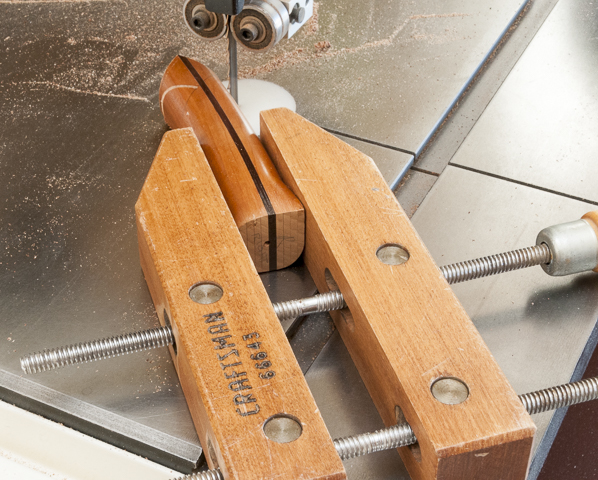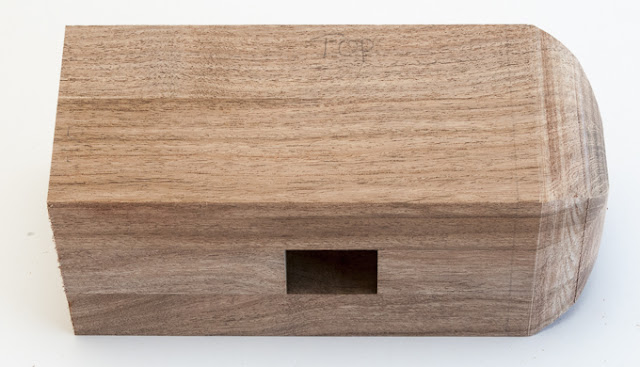I know in the last post I said that this post is supposed
to be Finishing the Mallets but as often happens things change. It’s getting close to Christmas and my wife
said we need some gifts for friends.
After thinking a bit I decided to make some refrigerator
magnets. It is something that appears to
be in universal use.
I really wanted to use something a little different that
a plain block of wood and in looking around came across a cutoff from the
Maloof rocker I made a few years ago. It
was from the rocker runner itself and is a curved laminated piece made out of 5
layers of cherry, a layer of katlox then 4 more layers of cherry. Just to make it more interesting I decided to
make a couple of them with the laminations running at a 45-degree angle.
Because the runner is curved and rounded I wanted to
clamp it in place to keep my fingers away from the bandsaw blade. The top photo below shows the setup to cut a
45-degree angle to form the base of the blank.
The bottom photo shows the blank flipped over and set for the second
45-degree cut which will give me a 90-degree corner.
Changing to a hand screw clamp to get better access I
made two more 45-degree cuts to give me my blank ready to turn.
This is the blank with the rough outline of the base in
pencil. You can see the laminations
running diagonally through the blank.
 Next is to drill a pilot hole in the center of the
blank. The green tape acts as my depth
gauge. I have a set of stops I can
attach to drill bits but seldom use them.
They are for a handful of sizes and I seem to always use sizes not in
the set.
Next is to drill a pilot hole in the center of the
blank. The green tape acts as my depth
gauge. I have a set of stops I can
attach to drill bits but seldom use them.
They are for a handful of sizes and I seem to always use sizes not in
the set.
After the pilot hole is drilled I change bits to a
Fostner bit. This type of bit gives me a
flat bottom hole. I need that for the
magnet to sit in. Speaking of magnets, I
really don’t like the refrigerator magnets that have a hard time holding up
anything heavier than a single sheet of paper.
To solve that I use a ½” rare earth magnet set in a steel cup to focus
the magnetic field. Also, when drilling
the hole, I go just a hair deep so when the cup and magnet are set in place
they are below the edge of the wood.
That’s to provide a buffer space so the magnet or steel cup won’t
scratch the refrigerator. The inset
shows what the rare earth magnet and its cup look like.
The blank can now be mounted on the lathe. To mount I made a fixture that gets mounted
in the scroll chuck, this is a section drawing. It’s just a piece of wood turned round with a
deep countersink and a pilot hole that a round head screw goes through. For correct registration to the jaws the
piece has numbers that match the jaw number.
Here the blank in place on the fixture
mounted in the lathe ready to turn. I
know the shape of the blank looks a little funny but that's because it is cut
on the diagonal, partially round in one axis and more or less square in the
other two.
Using a detail gouge, I shaped the blank until I got a
form I liked. No hard edges and
narrowed waist to give your finger someplace to grab. Below is the gouge I used, a closeup of the
cutting end, an intermediate shot during the turning and the final shape ready
for finish.
Things went well and I turned 6 pieces with no
problem. However, I had a small piece of
cocobolo that was the last piece to turn and as I was running the screw into the blank it split. Evidently the pilot hole was a
little too small.
When I gave one side a little nudge the whole thing split right in
half. Looking at the two pieces the
split faces looked like they might fit back together and I could continue. A liberal application of dark colored glue,
overnight clamping, drilling the pilot hole a size larger and I was read to
have at it again.
The turning went smoothly until I had a small catch that
broke my fixture sending the blank flying by my right ear. Not the preferred method of turning but it
happens. As they say, "Sometimes you're the hammer and sometimes you're the nail.". Retrieving the blank, it was
just fine no problem with the glue joint.
However, the fixture did not fare so good. The left photo shows the fixture and the
blank with part of the fixture still attached.
Rather than make a new fixture I thought I would try and repair it. I turned the broken face of the fixture flat
and glued a scrap of cherry to it as shown in the right photo.
Putting the fixture back into the scroll chuck I turned the
patch round and drilled a new pilot hole.
After that I mounted the offending blank back onto the chuck and very
carefully finished turning it.
Finishing was next and to make spraying easier I mounted the turned pieces on some scraps
using some long screws.
I applied four coats of lacquer, let them set for a few
days and wet sanded with 6,000 grit sandpaper.
Here are the finished pieces after installing the magnets. My wife declared the cocobolo piece in the
center hers and we will send the others out.
Next Up – Finishing the Mallets, I promise

















































